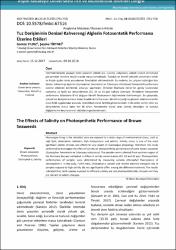| dc.contributor.author | YILDIZ, Gamze; TİRYAKİ, Şeyma | |
| dc.date.accessioned | 2019-01-21T07:28:51Z | |
| dc.date.available | 2019-01-21T07:28:51Z | |
| dc.date.issued | 2018 | |
| dc.identifier.uri | http://fenbildergi.aku.edu.tr/wp-content/uploads/2018/12/011001751-756.pdf | |
| dc.identifier.uri | http://hdl.handle.net/11630/5173 | |
| dc.description | Macroalgae living in the intertidal zone are exposed to a wide range of environmental stress, such as
high light, desiccation, radiation, high temperature and salinity. Salinity stress is one of the most
significant abiotic stresses and affects to vary aspect of macroalgae physiology. Therefore, this study
performed to investigate the effect of salinity on photosynthetic performance of some brown seaweeds
(Scytosiphon lomentaria ve Ectocarpus siliculosus). The samples were collected from southern region of
the Marmara Sea and cultivated in different salinity concentration (23, 33 and 43 ppt). Photosynthetic
performances of samples were determined by measuring variable chlorophyll fluorescence of
photosystem II. In this sudy, Fv/Fm ratio, chlorophyll-a content and relative electron transport rate of
samples exposed to high salinity did not significantly differ among the different treatment. The results
indicated that, both species exposed to different salinity are not photosynthetically stressed and they
are tolerant to salinity changes. | en_US |
| dc.description.abstract | İntertidal bölgede yaşayan deniz yosunları yüksek ışık, kuruma, radyasyon, yüksek sıcaklık ve tuzluluk
gibi çevresel streslere büyük oranda maruz kalmaktadır. Tuzluluk en önemli abiyotik streslerden biridir
ve birçok açıdan deniz yosunlarının fizyolojisini etkilemektedir. Bu nedenle, bu çalışma tuzluluğun bazı
denizel kahverengi alglerde (Scytosiphon lomentaria ve Ectocarpus siliculosus) fotosentetik performans
üzerine etkilerini belirlemek amacıyla yapılmıştır. Örnekler Marmara Denizi’nin güney kıyılarından
toplanmış ve farklı tuz derişimlerinde (23, 33 ve 43 ppt) kültüre alınmıştır. Örneklerin fotosentetik
performansı fotosistem II’nin değişen klorofil floresansının ölçülmesiyle belirlenmiştir. Bu çalışmada,
yüksek tuz derişimine maruz kalan örneklerin Fv/Fm oranı, klorofil-a içeriği ve göreceli elektron transfer
oranı farklı uygulamalar arasında istatistiksel olarak farklılık göstermemiştir. Elde edilen veriler farklı tuz
derişimlerine maruz kalan her iki türün, fotosentetik olarak stres altında olmadığını ve tuzluluk
değişimlerine karşı toleranslı olduklarını göstermektedir. | en_US |
| dc.language.iso | tur | en_US |
| dc.identifier.doi | 10.5578/fmbd.67516 | en_US |
| dc.rights | info:eu-repo/semantics/openAccess | en_US |
| dc.subject | Esmer deniz yosunu; Fotosentez; Klorofil-a; Tuzluluk | en_US |
| dc.title | Tuz Derişiminin Denizel Kahverengi Alglerin Fotosentetik Performansı Üzerine Etkileri | en_US |
| dc.title.alternative | The Effects of Salinity on Photosynthetic Performance of Brown Seaweeds | en_US |
| dc.type | article | en_US |
| dc.relation.journal | Fen ve Mühendislik Bilimleri Dergisi | en_US |
| dc.department | Afyon Kocatepe Üniversitesi | en_US |
| dc.identifier.volume | 18 | en_US |
| dc.identifier.startpage | 751 | en_US |
| dc.identifier.endpage | 756 | en_US |
| dc.identifier.issue | 3 | en_US |
| dc.relation.publicationcategory | Makale - Ulusal Hakemli Dergi - Kurum Yayını | en_US |



















